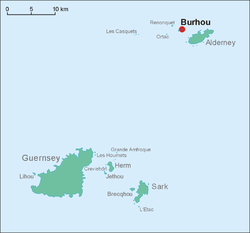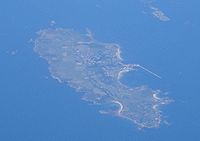
Burhou
Encyclopedia

Island
An island or isle is any piece of sub-continental land that is surrounded by water. Very small islands such as emergent land features on atolls can be called islets, cays or keys. An island in a river or lake may be called an eyot , or holm...
approximately 1.4 miles (2.25 km) northwest of Alderney
Alderney
Alderney is the most northerly of the Channel Islands. It is part of the Bailiwick of Guernsey, a British Crown dependency. It is long and wide. The area is , making it the third-largest island of the Channel Islands, and the second largest in the Bailiwick...
that is part of the Channel Islands
Channel Islands
The Channel Islands are an archipelago of British Crown Dependencies in the English Channel, off the French coast of Normandy. They include two separate bailiwicks: the Bailiwick of Guernsey and the Bailiwick of Jersey...
. It has no permanent residents, and is a bird sanctuary
Nature reserve
A nature reserve is a protected area of importance for wildlife, flora, fauna or features of geological or other special interest, which is reserved and managed for conservation and to provide special opportunities for study or research...
, so landing there is banned from March 15 to July 27. The island's wildlife
Wildlife
Wildlife includes all non-domesticated plants, animals and other organisms. Domesticating wild plant and animal species for human benefit has occurred many times all over the planet, and has a major impact on the environment, both positive and negative....
includes a colony of puffin
Puffin
Puffins are any of three small species of auk in the bird genus Fratercula with a brightly coloured beak during the breeding season. These are pelagic seabirds that feed primarily by diving in the water. They breed in large colonies on coastal cliffs or offshore islands, nesting in crevices among...
s (declining in numbers) and large numbers of rabbit
Rabbit
Rabbits are small mammals in the family Leporidae of the order Lagomorpha, found in several parts of the world...
s.
It has no landing stage as such, but visitors use a small inlet. In rough weather it may be impossible to land.
The Guernsey
Guernsey
Guernsey, officially the Bailiwick of Guernsey is a British Crown dependency in the English Channel off the coast of Normandy.The Bailiwick, as a governing entity, embraces not only all 10 parishes on the Island of Guernsey, but also the islands of Herm, Jethou, Burhou, and Lihou and their islet...
botanist E.D. Marquand called it, "the most desolate and lonely of all the islands in our archipelago." He had to spend the night there, as his return journey was delayed by fog.
The 1906 book, The Channel Pilot states -
- "Between OrtacOrtacOrtac is a small uninhabited islet about 5 km West of the coast of Alderney near to the islet of Burhou. It measures approx. 50 by 70 meters....
, Verte Tête and Burhou Island, are scattered many dangerous rocks, and ledges among which the streams run with great velocity."
The States of Alderney
States of Alderney
The States of Alderney is the parliament/council and the legislature of Alderney, part of the Bailiwick of Guernsey. The origin of the States is unknown, but has operated from the mediaeval period...
member, John Beaman
John Beaman
John Richard Beaman is one of the ten current States of Alderney Members and became the Chairman of the influential Policy and Finance Committee in January 2011. Prior to this, he was the Island’s Representative for Tourism...
has political responsibility for the island.
History

Prehistory
Despite being isolated, and inhabited briefly, and infrequently, Burhou has a long history. Formerly, like the rest of the English ChannelEnglish Channel
The English Channel , often referred to simply as the Channel, is an arm of the Atlantic Ocean that separates southern England from northern France, and joins the North Sea to the Atlantic. It is about long and varies in width from at its widest to in the Strait of Dover...
it would have been linked to both modern-day England and France by dry-land, many thousands of years ago.
Burhou, like many other Channel Islands (e.g. Lihou
Lihou
Not to be confused with Lihou Reef National Nature ReserveLihou is a small tidal island that is part of the Bailiwick of Guernsey, Channel Islands. It lies off the west coast of Guernsey and is the most westerly point in the Channel Islands. Coordinates: . The island was bought by the States of...
, Jethou
Jethou
Jethou is a small island that is part of the Bailiwick of Guernsey in the Channel Islands. It is privately leased, and not open to the public.It is immediately south of Herm and has an area of approximately .-History:...
), has the Norman
Norman language
Norman is a Romance language and one of the Oïl languages. Norman can be classified as one of the northern Oïl languages along with Picard and Walloon...
suffix -hou
-hou
-hou is a suffix found commonly in Channel Islands and Norman names. It is the Norman language version of the Old Norse holmr, meaning a small island, and often found anglicised elsewhere as "holm". It can still be found in modern Scandinavian languages, e.g...
, meaning a small island, from the Old Norse
Old Norse
Old Norse is a North Germanic language that was spoken by inhabitants of Scandinavia and inhabitants of their overseas settlements during the Viking Age, until about 1300....
holmr. According to Dr. S.K. Kellet-Smith, "bur" refers to a storehouse - "Burhou is just the place where a fisherman would place a depository for his gear".
However, signs of human occupation/visitation are much older. Flint
Flint
Flint is a hard, sedimentary cryptocrystalline form of the mineral quartz, categorized as a variety of chert. It occurs chiefly as nodules and masses in sedimentary rocks, such as chalks and limestones. Inside the nodule, flint is usually dark grey, black, green, white, or brown in colour, and...
flakes have been found on the island, and one is currently in the Alderney Museum. In 1847, F.C. Lukis found two standing stones, but these have since been lost, according to the archaeologist David Johnston.
The hut
According to the Assize Roll of the 14th century, Burhou was a rabbit warren, and a refuge for fishermen. As Victor Coysh deduces, this would have meant that there would have been some kind of shelter there, as it would be difficult for the fishermen to take refuge without it.A hut was built on the island in 1820 as a shelter for fishermen and sailors at the instigation of General Le Mesurier (The Governor), but was destroyed during the German occupation of the Channel Islands
Occupation of the Channel Islands
The Channel Islands were occupied by Nazi Germany for much of World War II, from 30 June 1940 until the liberation on 9 May 1945. The Channel Islands are two British Crown dependencies and include the bailiwicks of Guernsey and Jersey as well as the smaller islands of Alderney and Sark...
(the Nazis used it for target practice during WWII
World War II
World War II, or the Second World War , was a global conflict lasting from 1939 to 1945, involving most of the world's nations—including all of the great powers—eventually forming two opposing military alliances: the Allies and the Axis...
). The hut was replaced in 1953, with basic accommodation which is rented out to visitors by Alderney Harbour Office.
Attempts have been periodically made to raise sheep there. In 1900, a French couple lived there for a year. The soil is thin, and spray frequently goes right over the island, ensuring high soil salinity. The island has no fresh water supply for much of the year, and has to rely on shipments, or formerly tanks.
Flora and fauna
The island's animals are mainly of the avian variety, although rabbits are long established here. The island has many puffinPuffin
Puffins are any of three small species of auk in the bird genus Fratercula with a brightly coloured beak during the breeding season. These are pelagic seabirds that feed primarily by diving in the water. They breed in large colonies on coastal cliffs or offshore islands, nesting in crevices among...
s and some storm petrels. Although the latter have declined, they used to nest in the cottage's storm loft. Roderick Dobson in Birds of the Channel Islands said that puffins had been plentiful for over a century. The Birds of Guernsey (1878) by Cecil Smith states likewise. The puffins have had to compete with gulls, and in 1949, hundreds died from red mite infestation. The rabbit holes on the island make good nesting for them.
Amongst the plants noted here are sea spurry
Spergula
Spergula is a genus of about five plants belonging to the family Caryophyllaceae. Their usual English name is spurrey. Commonly found in grassland, the genus originated in the Northern Hemisphere, but is now found worldwide....
, forget-me-not
Forget-me-not
Myosotis is a genus of flowering plants in the family Boraginaceae that are commonly called Forget-me-nots. Its common name was calqued from the French, "ne m'oubliez pas" and first used in English in c. 1532. Similar names and variations are found in many languages.-Description:There are...
s, scarlet pimpernel
Scarlet pimpernel
Scarlet pimpernel is a low-growing annual plant found in Europe, Asia and North America...
, field bugloss, bracken
Bracken
Bracken are several species of large, coarse ferns of the genus Pteridium. Ferns are vascular plants that have alternating generations, large plants that produce spores and small plants that produce sex cells . Brackens are in the family Dennstaedtiaceae, which are noted for their large, highly...
and nettles. E.D. Marquand noted a mere 18 species of plant here in 1909, but by the late twentieth century Frances Le Sueur and David McClintock found 45, which they wrote up in the Transactions of La Société Guernesiaise

